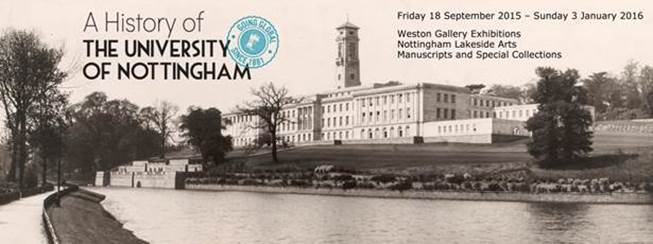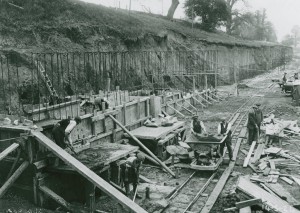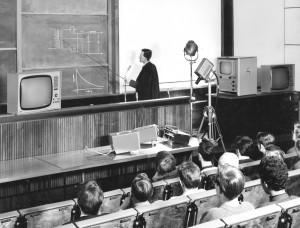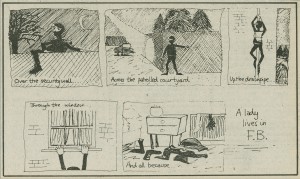
September 24, 2015, by Kathryn Steenson
Going Global! A History of the University of Nottingham
Our latest exhibition at the Weston Gallery opened last week, and it’s about a subject that is very close to us. Going Global! uses the University’s archives to show how a University College with a few hundred students grew to become the world’s first truly global University.
The documents and objects on display trace the origins of the University from 1881, when the University College Nottingham opened its doors for the first time. At a time when free elementary education ended at eleven, the aim of its Victorian founders was to provide the people of Nottingham with access to a University education.
Positioned on Shakespeare Street, in the heart of the city, the College had a staff of four professors, six lecturers and twelve teachers. Students could enrol from the age of fourteen upwards. These origins may have been unprepossessing but the College expanded both in student numbers and in curriculum. In 1928 Jesse Boot gifted the College part of his estate at Highfields, appropriately enough now where the exhibition gallery is, and this became the basis of University Park as we know it today.
This exhibition charts how a University College with a few hundred students grew to become the world’s first truly global University. It draws on material from the University’s own archives to focus on key events in its history, including the granting of a full University charter in 1948 and, in more recent times, the building of the University Hospital and the opening of the Jubilee, China and Malaysia campuses. The exhibition focuses on the student experience, using prospectuses, timetables, photographs and uniforms to explore changes in the student way of life from the days of the University College to the experiences of today’s 40,000+ undergraduates and postgraduates.
The guest curators for this exhibition are Professor John Beckett (School of Humanities) and Dr Andy Souter. Professor Beckett has written a new book on the history of the University and copies will be available to pre-order from the Box Office.
As always, we are running a series of walks and talks to accompany the exhibition. Places are free, but numbers are limited so please book in advance with the Box Office on 0115 846 7777 or call in in person.
The Lunchtime Talks will be held in the Djanogly Theatre from 1-2pm.
- Jesse Boot, the Highfields Estate, and the creation of University Park, 19285 October 2015Professor John Beckett looks at how the Nottingham entrepreneur Jesse Boot facilitated the move which took the University College from cramped headquarters in Nottingham, to a new campus and a new College building, in the 1920s. The Trent Building, as it is now called, with its iconic clock tower, remains a symbol of the University, and is now replicated on the campuses in China and Malaysia.
- Photographing University Park2 November 2015Dr Andy Souter not only had the task of selecting from a huge range of original ‘historic’ photographs, but also of spotting gaps and filling them. In doing so, he spent many hours on the University’s different UK campuses and surrounding areas, and found many hidden gems that reflect University and student life. In this talk Dr Souter will explore the variety of challenges faced in addition to his inspiration and discoveries made during his work on the project.
- From Modest Beginnings to Global Institution7 December 2015Emeritus Professor Malcolm Jones has been linked to the University since he arrived as an undergraduate in 1958, just ten years after it received a Royal charter. Over the years which followed he was a student, a lecturer and a professor. He also became Dean of the Arts Faculty, Pro-Vice-Chancellor and Honorary President of Convocation. In his talk he offers fascinating glimpses into the ways in which the University has developed and changed since the 1950s, combining institutional history with reflections based on an unusually varied personal experience.
The two guided walks around the University Park campus will be led by Professor Beckett and start from the Weston Gallery.
- The Jesse Boot Gift Wednesday 30 September, 4.30.
This walk will last approximately 1.5 to 2 hours and will focus on University Park’s unique heritage, looking at the land and buildings which were given by Jesse Boot to the University. - The Student Experience Sunday 11 October, 2.30.
This circular walk will look at the history and architecture of different types of student accommodation on University Park campus, from former family homes to purpose built halls of residence. The walk will last approximately 2 to 2.5 hours.
Going Global: A History of the University of Nottingham runs until 3rd January 2016 at the Weston Gallery, Nottingham Lakeside Arts, University Park. It is open to the public 11am-4pm Monday to Friday, and 12 noon-4pm Saturday and Sunday. Please check the website for opening times at Bank Holiday and over the festive period.
To receive invitations to future private views of our exhibitions, please sign up to our exhibitions mailing list. To keep informed about Manuscripts & Special Collections in general, sign up to our newsletter or follow us on Twitter @mssUniNott. We collect records relating to any period of the University’s history, but we have some notable gaps in our holdings, especially relating to the Malaysia and China campuses. If you can help, we’d love to hear from you!
No comments yet, fill out a comment to be the first




Leave a Reply